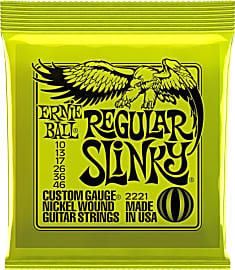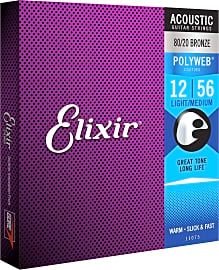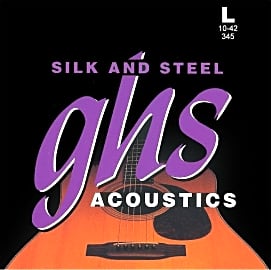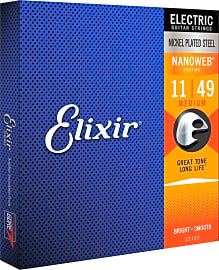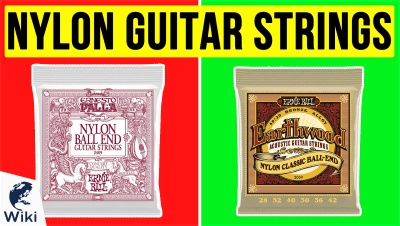The 8 Best Guitar Strings

This wiki has been updated 38 times since it was first published in October of 2016. In a category so subjective, it would be impossible to recommend any one make of guitar string. So, instead, we have compiled a comprehensive selection of top quality options and detailed their individual characteristics, so you can find the right ones based on the type of sound you are going for in your music. Our selection includes choices for electric and acoustic instruments. When users buy our independently chosen editorial recommendations, we may earn commissions to help fund the Wiki.
Editor's Notes
April 09, 2019:
While choosing the right kind of guitar strings is primarily dependent on what kind of style the individual musician plays, and that may even vary for them depending on what song they are playing, we can recommend options based on their durability and high quality engineering that each brand puts into their strings to deliver the freshest, highest performing options.
The D'Addario EXP took the top spot for offering a corrosion barrier sleeve, to ensure they are sealed upon arrival, plus they've developed a coating for durability that doesn't affect the quality of the sound.
Selecting Your Strings
Nowadays, hex core is common since it grips the outer wire well, giving great stability that may feel stiffer, but that is less prone to premature breakage.
We're not going to string you along: settling on the "right" guitar strings is, in large part, subjective, a decision that must take into account your desired tone, your guitar, your personal comfort and skill level, and so much more. What we can do, however, is arm you with information that will help you make an informed choice and hopefully get you to your dream strings faster. That's why we've outlined some of the terms you'll encounter while you're making your selection.
The first, gauge, refers to the thickness of the string. You'll often see descriptors like "extra light," "medium," "heavy," and so on, but because these terms are relative and vary between manufacturers, you'll want to become accustomed to looking for actual measurements. Customarily, players refer to an entire set by the measurement of the high E string, for simplicity's sake, since each string on the guitar is a different thickness. Those on the lighter side start around .008, moving all the way to .012 or more on the heavier end. Generally, lighter sets work well for beginners, fingerpickers, and those playing on more delicate instruments, while heavier strings are great for loudness, slide playing, and heavy strumming.
Next up are the materials. An electric guitar uses strings made from some type of metal; pure nickel, nickel-plated steel, and stainless steel are the top choices, with the third being less resistant to both corrosion and finger squeaks. Popular options for acoustic guitars, moving from bright to less bright, include 80/20 bronze (sometimes just called bronze), phosphor bronze, and silk and steel. These materials impact the strings' durability, although some manufacturers now offer coated versions of acoustic and electric strings that supposedly last longer than their uncoated counterparts.
Then comes the core. The low E, A, D, and (sometimes) G strings are formed by wrapping a wire around a core that can be either round or hexagonal in shape (the latter is called hex core). Nowadays, hex core is common since it grips the outer wire well, giving great stability that may feel stiffer, but that is less prone to premature breakage. Round core strings tend to be more flexible, providing a vintage tone and greater sustain.
Finally, you'll often see information about how the strings are wound. This refers to the shape of the material that winds around the core, whether it's a round wire (roundwound) or a flat wire (flatwound). Roundwound strings have more grip thanks to a more textured surface, and they tend to sound brighter. Although they don't usually last as long as flatwound strings, they're the more common (and less expensive) choice.
Tuning Tips
You could have the most rockin' strings out there, but if your guitar is not in tune, well, you're not going to sound all that great. Unfortunately, tuning can sometimes seem daunting, even mysterious, to beginning players, but really all anyone needs is a little education and practice. That, and a few tricks to make getting in tune as simple as possible.
Instead, take a moment to compare it to those next to it, because the one that's out of tune may not be the one you initially thought.
The first tip is one that most guitar players have heard, but it bears repeating because it's important: always tune up. In other words, loosen the string (causing it to sound flat), then tighten it up to the desired pitch. Why? Because with this method, you'll be removing any minute slack that would otherwise remain and push you out of tune as you begin to play. And don't skip this step. You need to tune every time you pick up your axe to play.
Another thing you can do is work on training your ear. An electric tuner is an excellent tool, but try to listen carefully and tune thoughtfully. Doing so will teach you to hear whether you're in tune while you're playing, an excellent skill to have. You can also test yourself by sounding a note and trying to guess whether it's in tune, flat, or sharp without looking at your tuner.
Then, when you're playing and you hear that a string is out of tune, don't stop and immediately begin tuning that one string. Instead, take a moment to compare it to those next to it, because the one that's out of tune may not be the one you initially thought.
You can make tuning easier before you even pick up your guitar, too, by taking care of the instrument and its strings. Guitars are sensitive to adjustments in temperature and humidity, so consider investing in a humidifier or dehumidifier if you live in more extreme and changing climates. Avoid sharp temperature changes if you can, and know that if your guitar does sit in overly hot or cold environments, its tuning may change quite a bit. And if you've been treating your guitar right but it won't stay in tune, it's probably time to pick up some new strings.
Cat Got Your String?
The guitar is an old instrument with various ancestors, and just as it went through leaps and developments, so too did its strings. For instance, classical guitars nowadays take nylon or silver-plated copper strings, but up until the beginning of the 20th century, these strings were of the catgut variety. No, this doesn't mean they were made from the stomachs of felines; rather, the materials came from the intestinal walls of certain farm animals, usually sheep, goats, or perhaps cattle (we're not sure this is much better).
The push for nylon strings is largely thanks to Albert Augustine. Unable to source catgut due to shortages produced by World War II, the eponymous business owner and instrument maker developed this new version, but had trouble pitching his idea to DuPont, whom he needed to manufacture the strings. As the story goes, a blind sound test convinced the DuPont heads that the nylon version did, in fact, sound better than the old catgut variety, and the first commercially produced nylon strings began rolling off the line in 1948.



